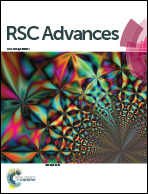Simultaneous reinforcement and toughness improvement of an epoxy–phenolic network with a hyperbranched polysiloxane modifier†
Abstract
An epoxy–phenolic network is modified with hyperbranched polysiloxane (HBPSi). The addition of HBPSi-2, which has medium molecular weight, can significantly decrease the viscosity of the uncured epoxy–phenolic system and increase the crosslinking density and homogeneity of the cured crosslinking network. With 10% HBPSi-2, the mechanical properties of the samples are improved comprehensively: tensile modulus and maximum strength increase by 11.4% and 36.2%, respectively, while elongation at break and impact strength increase by 153.8% and 186.7%, respectively. The comprehensive improvements in the mechanical properties are attributed to combined effects of crosslinking density, network rigidity, cohesive density and the matrix-modifier compatibility. What is more, HBPSi-2 also significantly increases the char yield of the material and decreases the thermal weight loss rate, indicating an improved thermal stability. All these results may provide a new strategy for toughness and strength improvement of the epoxy–phenolic network.



 Please wait while we load your content...
Please wait while we load your content...